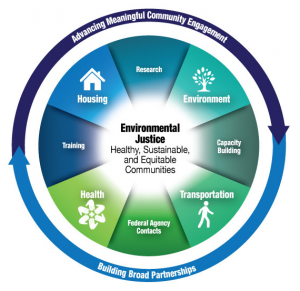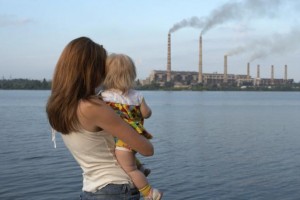By Jackie Lombardo, SafeMinds Board Member
SafeMinds is speaking out on environmental equality and appropriate services for individuals with autism and developmental disabilities.
The Environmental Protection Agency (EPA) has asked for comments to their 2016-2018 Draft Environmental Justice Interagency Working Group Framework. The Framework is designed to provide equal access to a healthy environment for all people, especially those disproportionately affected by environmental inequality, through intergovernmental agency cooperation.
Individuals with autism and developmental disabilities need environmental protection – autism has both genetic and environmental causation factors. This population is more likely to be exposed to tobacco smoke and other environmental toxins, and to have inadequate nutrition.
 In addition, there is also a clear association between disability and socioeconomic standing. Environmental inequalities force affected individuals into low cost housing with less access to transportation, a lower economic status, and worse health and mortality rates more than their non-disabled peers. Facing unequal environmental issues, individuals with autism and developmental disabilities are more likely to become poor, remain poor, and experience longer periods of poverty than their peers.
In addition, there is also a clear association between disability and socioeconomic standing. Environmental inequalities force affected individuals into low cost housing with less access to transportation, a lower economic status, and worse health and mortality rates more than their non-disabled peers. Facing unequal environmental issues, individuals with autism and developmental disabilities are more likely to become poor, remain poor, and experience longer periods of poverty than their peers.
The U.S. is currently experiencing a rising wave of affected adults as children with autism and developmental disabilities age out of the education system. Once out, there are little or no transition programs or other appropriate services. However, EPA’s Framework can help with a focused, multi-agency effort addressing environmental, social, economic, and public health burdens in the autism community.
Our comments are below. Consider adding your voice by emailing EPA: [email protected]
Environmental Protection Agency
Federal Interagency Working Group on Environmental Justice
1200 Pennsylvania Ave. NW
Washington, DC 20460
Comments to [email protected]
September 25, 2015
RE: SAFEMINDS COMMENTS:
EPA’S DRAFT 2016-2018 ENVIRONMENTAL JUSTICE INTERAGENCY WORKING GROUP (EJ IWG) ACTION AGENDA FRAMEWORK
SafeMinds is a 501(c)3 non-profit grassroots organization comprised of parents, self-advocates, scientists, clinicians, government relations specialists, communications professionals and non-profit experts. SafeMinds mission is to end the autism epidemic by promoting environmental research and effective treatments. We work to prevent new cases and improve the lives of those who have autism today.
SafeMinds is grateful for the opportunity to enhance EPA’s 2016-2018 EJ IWG Framework to provide equal access to a healthy environment where adverse human health and environmental impacts no longer disproportionately affect minority and low resourced populations including a new group – individuals with autism and other developmental disabilities.
There is a growing necessity, of unprecedented magnitude, for attention to the economic and environmental needs of children and adults with autism and developmental disabilities. Adults with autism and their families are in crisis with an ill-prepared and underfunded system. Autism rates have skyrocketed from 1 in 2500 children prior to 1980 to 1 in 68 today, with no sign of abating[1] [2]. Autism now costs society $268 billion and is expected to rise to $1 trillion by 2025 if trends are not reversed[3]. The surge in children with autism has led to a tsunami of adults as these children age out of the education system.
Inadequate transition programming and/or an absence of evidence-based treatment for these individuals has resulted in large numbers of children and adults with autism remaining without appropriate services. Local communities lack the capacity to address and implement solutions to meet the growing and unique needs of these individuals.
However, EPA’s 2016-2018 EJ IWG Framework can help right this injustice with formal and specific inclusion of autism and developmental
disabilities as a target group and a focused effort to address environmental, social, economic, and public health burdens in the autism community. Promoting community-based solutions, and increased coordination among federal agencies, will ensure that all populations in need are cared for.
Therefore, SafeMinds trusts that individuals with autism and developmental disabilities will be formally and specifically outlined in EPA’s 2016-2018 EJ IWG Framework as among those at high risk and in need of attention.
Autism: An Environmental Justice Issue
Autism has a genetic and environmental causation component. While genetic factors are clearly implicated in autism causation, genetic differences  have been found in only 15% of cases and nearly all autism-associated genes to date are low penetrance, meaning other factors must be involved for autism to be expressed. Genes do not easily explain the multitude of distinct clinical or epidemiological features suggesting that early environmental exposures also contribute. Certain toxicants have been linked to autism risk, for example, pesticides[4], lead[5], air pollution[6] from living near congested roads, superfund sites, and mercury[7] in fish from local polluted waters.
have been found in only 15% of cases and nearly all autism-associated genes to date are low penetrance, meaning other factors must be involved for autism to be expressed. Genes do not easily explain the multitude of distinct clinical or epidemiological features suggesting that early environmental exposures also contribute. Certain toxicants have been linked to autism risk, for example, pesticides[4], lead[5], air pollution[6] from living near congested roads, superfund sites, and mercury[7] in fish from local polluted waters.
In general, infants and children suffer unequal exposures to environmental pollution making them especially vulnerable to the health impacts of environmental injustice due to unique biological vulnerabilities and patterns of behavior. In particular, children with autism or learning disabilities are at even more increased risk of exposure to all social categories that adversely affect health including toxic chemicals. Additionally, environmental hazards affect some families at a higher rate than others leaving their children at greater risk for autism.
Adults with autism and learning disabilities face environmental justice issues through worse housing, transportation, economic status, and health and mortality than their peers. The vast majority of adults with autism is unemployed or underemployed and depends on government benefits for survival. These inequalities result in this population being forced into low cost housing and harmful exposures as well as more stress and isolation than other groups.
Environment Dictates Destiny for People with Autism and Developmental Disabilities
There is an association between socioeconomic standing and disability. An August 2015 paper in The Lancet[8] explains individuals with autism and developmental disabilities are more likely not only to live in low cost housing, but also to be exposed to tobacco smoke and other environmental toxins, to be less likely to have adequate nutrition or to have been breastfed, and to have increased risk of exposure to violence and neglect than their non-disabled peers.
Facing these unequal environmental issues, individuals with autism and developmental disabilities are also less likely than their peers to be resilient; due in part to cognitive difficulties as well as less access to wealth, social connections, and services. As a result, they are more likely to become poor, remain poor, and experience longer periods of poverty than their peers.
Environmental Health Literacy
The autism and developmental disabilities community, and families at higher risk for autism, would benefit from increased environmental health literacy that can be undertaken by the Working Group. Taking steps at the community and individual level to avoid harmful exposures, or to bolster resiliency, may aid in prevention of new cases, decrease the severity of co-occurring distressing conditions and increase quality of life. The autism and developmental disabilities community will have unique communications needs, interaction styles and dissemination channels which should be addressed by the Framework[9].
Once again, SafeMinds is grateful for this opportunity to provide comments to EPA. The 2016-2018 EJ IWG Framework will only provide true equal access to a healthy environment when individuals with autism and developmental disabilities are formally and specifically included and protected.
Thank you for the opportunity to submit comments.
Respectfully,
Jackie Lombardo
SafeMinds Board of Directors
 HOW SAFEMINDS IS HELPING
HOW SAFEMINDS IS HELPING
This is one example of how SafeMinds is helping create a safer world for our children. You can help us continue our work by donating to our Policy and Justice Fund, our Making a Difference Research Fund, or our Parent and Family Education Fund, or by contacting us to volunteer.
[1] Centers for Disease Control: http://www.cdc.gov/media/releases/2014/p0327-autism-spectrum-disorder.html,
[2] SF Autism Society Autism Rising: http://www.sfautismsociety.org/uploads/1/1/7/4/11747519/autism_rising_2015.pdf
[3] UC Davis: http://ucdmc.ucdavis.edu/publish/news/newsroom/10214
[4] Neurodevelopmental Disorders and Prenatal Residential Proximity to Agricultural Pesticides: The CHARGE Study, Shelton, Geraghty, Tancredi, Delwiche, Schmidt, Ritz, Hansen, and Hertz-Picciotto, http://ehp.niehs.nih.gov/wp-content/uploads/advpub/2014/6/ehp.1307044.pdf
[5] A Research Strategy to Discover the Environmental Causes of Autism and Neurodevelopmental Disabilities, Landrigan, Lambertini, and Birnbaum, http://www.ncbi.nlm.nih.gov/pmc/articles/PMC3404655/
[6] Autism Spectrum Disorder and Particulate Matter Air Pollution before, during, and after Pregnancy: A Nested Case–Control Analysis within the Nurses’ Health Study II Cohort, Raz, Roberts, Lyall, Hart, Just, Laden, and Weisskopf, http://ehp.niehs.nih.gov/1408133/
[7] Neurobehavioural effects of developmental toxicity, Grandjean, Landrigan, http://www.sciencedirect.com/science/article/pii/S1474442213702783
[8] Demography still dictates destiny for children with disabilities: http://thelancet.com/journals/lancet/article/PIIS0140-6736%2815%2961459-3/fulltext
[9] The Emergence of Environmental Health Literacy—From Its Roots to Its Future Potential: Finn and O’Fallon, http://ehp.niehs.nih.gov/1409337/



